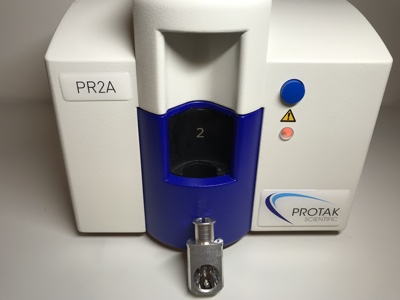For nearly 40 years the pharmaceutical and healthcare sectors have used cold, gaseous processes to deliver decontamination of environments. Multimillions have been spent on developing these technologies to deliver cold decontamination outside of an autoclave reliably.
Notably and perhaps most palatable for pharma and healthcare would be the hydrogen peroxide decontamination cycle. When delivered correctly hydrogen peroxide offers excellent biological inactivation and is by far the most environmentally friendly of all the gaseous decontamination processes. Hydrogen peroxide can routinely deliver a very robust decontamination, more than the industry norm of inactivation of a million geobacillus stearothermophilus.
For the last four decades, decontamination cycle performance validation has been based on a nineteenth century principle: to place stainless steel carriers or tokens containing a known population of bacteria (biological indicators; BI) into the decontamination process.
Once the decontamination cycle is completed, these carriers are placed into a suitable growth media and incubated for up to seven days. Once this lengthy process is complete, the BI are observed – a change in the growth medium indicates the presence of remaining bacteria. The death of these bacteria and therefore absence of change in the medium, demonstrates the success of the decontamination process. Although this process may sound effective, it is certainly not without disadvantage. In fact, this validation process is fraught with dangers, peril and difficulties.
The fermentation process used to culture the bacteria is notorious for its batch to batch variation. The biological rather than chemical nature of this process results in uncontrollable discrepancies between batch populations – an undesirable reality facing the decontamination industry.
The BI from one supplier is usually totally different to another. Select a BI supplier and stick to it. Change at your peril. Secondly, there is the issue of delivering the bacterial population onto its carrier – although technically possible, this is neither practical nor robust. Both the number and distribution of bacteria deposited is inconsistent (clumping and layering) ultimately resulting in both ‘batch to batch’ and ‘within batch’ variation. Consequently, every BI is at best slightly different to the next and at worst vastly different. Batches of BI are so routinely changeable that it is necessary for manufacturers to indicate the mean bacterial population and associated D value.
Kill prowess
The D value is the time it takes for a million of the bacterial population to reduce by an order of magnitude (1,000,000 to 100,000) when exposed to a dose of H2O2 in a controlled environment. The D value is typically set by the BI manufacturer, with both dose and environmental conditions undisclosed. Therefore, the only real worth of the D value is the indication of comparative resistance to other BI, in other words which BI is harder to kill.
Assuming the environmental conditions and dose are constant, the time to kill all the bacteria may be as low as six minutes for a low resistance (low D value) BI, or as high as 20 minutes, for a high resistance BI. This is intended to be a consistent test, yet clearly it is not.
In addition to a validation tool that may differ dramatically between batches, we have to contend with a host of manufacturing, storage, contamination, use and incubation hurdles that can all create difficulties.
The picture here is that using biological indicators is hard work and many factors can create both rogue results and inconsistencies, which can create hours, days, weeks or even months and years of additional work.
Putting these drawbacks aside and assuming BI perform perfectly – what is the result? BI take a long time to work (with up to seven-days incubation) and the result is binary. They are costly in terms of operational impact, with many companies using up to three BI in each position, bearing in mind hundreds and even thousands of positions may be studied during cycle development.
One safe way of limiting risk is to design a decontamination cycle that is very robust and designed to inactivate a high resistance BI. However, this requires very long cycles, lengthy injection/dwell phases and massive aeration cycles to remove the gas or vapour. Although longer cycles reduce risk, they have a negative impact on both productivity and efficacy.
We are in the age of lean manufacturing processes and yet it is clear that BI are anything but lean; they are in fact the complete opposite. Some production facilities have an annual usage of over one hundred thousand BI, requiring whole departments to administer the qualification process. This can cost millions even when it goes perfectly, which often it does not.
The industry has been stagnating, with the belief that there are no other alternatives, until now.
Solution to continuous monitoring
The time is now to embrace a twenty-first century, digital validation tool called enzymatic indicator (EI). The EI is everything we need to deliver successful decontamination validation quickly, consistently and efficiently.

The EI is a biological challenge. It is an enzyme from a very hardy thermophile, many times more resistant to inactivation than the bacteria used in BI.
The enzyme inactivates and just like a BI, the EI delivers a measure of decontamination efficacy rather than an indication of “chemical in the vicinity of the test”, such as a chemical indicator.
Even the very best chemical indicators only deliver a measure of chemical in the area, rather than a measure of biological inactivation, like a BI or EI can.
The enzyme on the EI is used to catalyse a bioluminescent assay. Put simply, the enzyme before inactivation can deliver a known and measurable volume of luminescence. Exposure to oxidisation processes such as hydrogen peroxide and ethylene oxide, degrade and inactivate the enzyme in both a time and dose responsive way and as such less luminescence is produced.
The EI efficacy measurement process involves a luminescent assay, consisting of four parts: The EI test strip, the luminescent reagents, a luminometer with a digitally delivered automatic reading process and analysis of results through a software platform called Athena.
Decontamination efficacy
The EI test process has been engineered to deliver a robust test. It is not binary, rather the EI test is quantitive. Each single use EI test delivers a measure of decontamination efficacy that correlates simply to a Log reduction that ranges from <2.5 Log to >9 Log.
The reader fully automates the reading process. The test is completed with the press of one button and requires only 60 seconds waiting time until accurate process efficacy results are delivered.
The time that EI save is incredible. The value EI deliver is clear and the technology is rapidly becoming the validation tool of choice for pharmaceutical manufacturers around the globe.
EI technology has been developed by Public Health England in the last 15 years and Protak Scientific is the globally exclusive licensee of the technology. Protak has engineered the technology specifically for use in cold oxidisation process decontamination applications, with imminent certification to ISO 13485, pending FDA registration. The technology can be relied upon to deliver a qualification tool that meets all expectations of today’s forward-thinking industry.
It really is very simple, EI measure decontamination efficacy simply and easily. EI take away all the hard work, all the guesswork and deliver total cycle mapping and understanding on the very first cycle. EI deliver qualification in a way that totally revolutionises the industry and does so with a high degree of reliability. EI are not inoculated like BI, but instead are manufactured with a very high degree of accuracy and a batch variance of less than 10% as compared to the 350% for BI.
Now is the time to say “bye-bye to the BI” and “hello to the EI”. Now is the time to move from a nineteenth century process to a twenty-first century technology that has been engineered specifically for the process and task at hand.
Protak Scientific is working with the UK’s MHRA to establish an industry focus group with plans to meet with the agency at its new offices in Canary Wharf to discuss with the regulator directly how the new EI technology can be introduced and implemented within industry.
This article appeared in the October issue of Cleanroom Technology.




